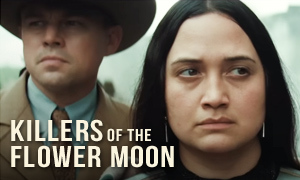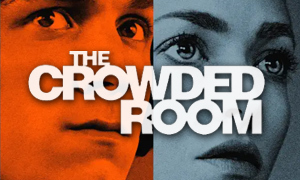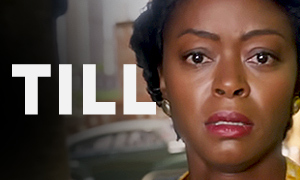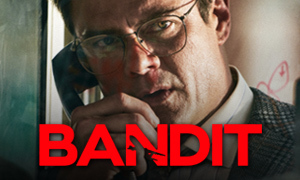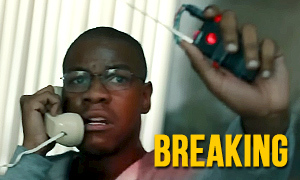Breaking: History vs. Hollywood
John Boyega
Born: March 17, 1992
Birthplace:
Peckham, London, England, UK
Brian Brown-Easley
Born: 1983
Birthplace: Williamstown, New Jersey, USA
Death: July 7, 2017, Wells Fargo Bank, Marietta, Georgia, USA (shot by police sniper)
Connie Britton
Born: March 6, 1967
Birthplace:
Boston, Massachusetts, USA
Stephanie Steiger
Birthplace: USA
Bio: WSB-TV Assignment Editor | Renamed Lisa Larson in Movie
Why did Marine veteran Brian Brown-Easley hold up a bank?
The Breaking true story reveals that Marine Brian Brown-Easley, 33, had been staying afloat financially by way of a small disability check from the Department of Veterans Affairs. When the monthly payments stopped coming and he was repeatedly turned away by the regional VA benefits office and the Veterans Crisis Line, he knew that he would soon be on the streets. On July 7, 2017, he held up a Wells Fargo bank in Marietta, Georgia, a suburb of Atlanta, demanding the VA pay him what he believed he was still owed. Easley wanted his story heard, which was another motivation for holding up the bank.
"I'm going to be out on the street tomorrow. I have a hotel room tonight, and tomorrow I have nothing," Easley told WSB-TV during a phone call from the bank. "I'm just going to be out on the street, homeless, no food, no nothing. I don't have much money left, not to survive the rest of tomorrow."
Easley's ex-wife, Jessica, said that he wanted to surprise his 8-year-old daughter, Jayla, with a dog. She thinks that when the payment from the VA didn't arrive, he realized he would no longer be able to come through on the surprise. It's possible this caused him to reach his breaking point and decide to go to a bank. -Task and Purpose
What did Brian Brown-Easley do in the Marines?
While conducting our Breaking fact-check, we learned that Lance Corporal Brian Easley had been a supply clerk, serving in Kuwait and Iraq. He had been part of the 2nd Marine Logistics Group, based out of Camp Lejeune. While in Iraq in 2005, he served as a warehouse clerk at Al-Taqaddum Air Base (TQ), working up to 17 hours a day to fill supply orders for Marine combat units functioning throughout the Al-Anbar province. Though he wasn't near the front lines, Easley told WSB-TV that he had "one close call during a security detail." A fellow soldier named James Dunlap, who served with Easley, said that mortar fire was a regular occurrence at the base, often causing everyone to hurry to the bunkers.
After spending a total of four years in the military, Brian Easley was honorably discharged in 2005. He returned home to his mother in Jefferson, Georgia where he was plagued with back problems from his grueling work on the base. He also suffered from mental health issues. -Task and Purpose
Did the real Brian Brown-Easley have an ex-wife?
Yes. After leaving the military in 2005 and rejoining his mother in Jefferson, Georgia, Brian met a cashier at Walmart named Jessica Tate (renamed Cassandra in the movie). It wasn't long before they married and had a daughter, Jayla (renamed Kiah in the film). However, Brian would disappear for long periods and his symptoms were getting worse. He stayed in a number of different places, including relatives' guest rooms, nonprofit housing, and VA mental hospitals. When things got really bad, he would sleep in his car. He used some of the disability money he was receiving from the government to pay child support.
Did Brian Brown-Easley suffer from PTSD?
Yes. In researching how accurate is Breaking, we learned that he had been diagnosed with PTSD. He also suffered from paranoia and schizophrenia. This was evident during his call to WSB-TV from the bank. He claimed that he was being followed and had been the target of four kidnapping attempts, blaming the near-abductions on a secret society and his half-brother Calvin. "I don't know these people. They seem to be able to track me wherever I go. They have my information," he said.
Like many veterans, Brian had trouble adjusting to life at home and his family noticed it. Gone was the sense of purpose and community that the military provided. When he got out in 2005, he had traded the brotherly world of the armed forces for a more isolating and superficial existence on the homefront. Brian Easley had been an introvert with few friends before enlisting at age 18. The military had brought him out of his shell and had given him a social group. Following his discharge, he'd found himself cut off from that group and in largely unfamiliar territory. -Task and Purpose
Did Brian try to get his life straightened out prior to holding up the bank?
Yes. In addition to stints in a VA mental hospital, Brian had enrolled in computer classes at Lincoln College of Technology just months before the episode at the bank. He had also bought his daughter Jayla a phone so that he could call her regularly. He prayed with her via Facetime almost every night, and he helped her with her homework. He did hold various jobs in the early years after being discharged, including at a Home Depot distribution center and a Church's Chicken. -Task and Purpose
"I went back to a warehouse job for a little while and I went to school for a bit. I even went to film school for a bit," he told WSB-TV during his call to the channel from the bank.
Did Brian Brown-Easley claim to have a bomb?
Yes. The Breaking true story confirms that after quietly entering the Wells Fargo at around 9:30 a.m., he slid the teller a note that stated he had a bomb. He claimed that his backpack contained C-4 explosive. He placed a call to a 911 operator and also called a local news channel, WSB-TV, to alert them to the situation. It wasn't long before the fire department, bomb squad, SWAT team, and crisis negotiators arrived. Representatives showed up from the FBI, ATF, and GBI as well, the same organizations that had investigated the 1996 bombing at the Summer Olympics in Atlanta.
Did Brian Brown-Easley allow the bank customers to leave?
Yes. A Breaking fact-check confirms that, like in the movie, Easley allowed the customers and all but two employees to leave the Wells Fargo bank prior to contacting 911 and a local news channel. -LA Times
How much money did Brian Brown-Easley demand the bank give him?
Easley did not intend to rob the bank. In fact, he ignored piles of cash that an employee had left sitting out prior to fleeing. He wanted only $892 from the VA. It was the monthly disability payment that had not come, which he believed was still owed to him. On a side note, the film was originally called 892 when it premiered at Sundance in January 2022.
Why didn't Brian Brown-Easley receive his monthly VA benefit payment?
The Breaking movie true story reveals that he had received his last payment of $892 from the VA on June 1st and was expecting his next payment to be deposited on July 1st. When it didn't show up in his account, he started to wonder if it was a tuition issue. After visiting the college, a counselor got him an appointment with the VA's regional benefits office.
According to a VA spokesperson, Easley "was extremely agitated and belligerent" when he arrived at the appointment, so much so that he had to be briefly placed in handcuffs. When he calmed down, they explained to him that his payment had been recouped because he'd failed to complete college courses, and as a result, the courses were no longer covered by the GI Bill tuition assistance program. Easley said that he would return with the proper paperwork to set up a payment plan but never came back.
The VA claims that it had mailed Easley five letters regarding the tuition issue, but they never heard back. This isn't a surprise given that Easley was bouncing around a lot during that time. -Task and Purpose
Was the lead crisis negotiator a former Marine like Easley?
Yes. Michael K. Williams' character, Sgt. Eli Bernard, is based on the real lead crisis negotiator at the scene, Sgt. Andre Bates, who, like Easley, is black and a former Marine. It's true that to establish a rapport with Easley, Sgt. Bates told him, "I'm going through it with Veterans Affairs myself, so I know it can be difficult when they drag their feet." It should be noted here that the names of virtually all of the law enforcement officers at the scene were changed for the movie. It seems that this was likely done for legal reasons.
Was Brian Brown-Easley nice to his two hostages?
Yes. In answering the question, "Is the Breaking movie accurate?" we learned that Easley never yelled or became violent with the two female bank employees who he held hostage. One of the employees described Easley as being "very respectful." He even joked a bit during the ordeal and one of the women told him that she sympathized with his situation. The employees' descriptions of him are almost reminiscent of Forrest Tucker, the polite bank robber portrayed by Robert Redford in 2018's The Old Man & the Gun.
Did Brian Brown-Easley answer calls from random bank customers?
Yes. In exploring the Breaking true story, we discovered that Easley would answer calls from random customers, politely telling them that there was an emergency situation unfolding and they should try calling again later. -Task and Purpose
Did Brian Brown-Easley promise to let his two hostages go if he decided to detonate the bomb?
Yes. He made it clear that he wasn't planning on killing anyone other than possibly himself and would let the two employees go if he decided to detonate the bomb. "I already told them if I detonate this bomb, I'll let them go first," he told Stephanie Steiger, the assignment editor at WSB-TV who took his call. "These ladies are very nice, and they've been very helpful and supportive." -Task and Purpose
Did Brian Brown-Easley agree to trade a hostage for a pack of cigarettes?
Yes. The Breaking movie fact-check confirms that crisis negotiator Sgt. Andre Bates, who inspired Michael K. Williams' character, got Brian Brown-Easley to agree to a deal: a pack of Newport cigarettes for one of the two hostages in the bank. Bates informed his superiors of the deal and they quickly began to devise a plan for the trade.
Was Brian Brown-Easley killed by a police sniper?
Yes. Easley was shot in the head with a single bullet by Cobb County Police Department (CCPD) Officer Dennis Ponte, a sniper on the force with a military past. He had been hiding in the woods and had let his commanders know he had a clean shot. He asked them if he should take it. "Not at this time," they told him. For one, the other members of the tactical team were not in position. Though Officer Ponte had heard on his radio that Easley might free a hostage, he didn't see any progress being made to that end. "There was no effort or energy being put forth toward releasing somebody," he later told the Georgia Bureau of Investigation (GBI).
According to Aaron Gell's article, Officer Ponte made the decision himself to take the shot, catching hostage negotiator Sgt. Andre Bates and the various commanders completely off guard. Initially framed by Chief Mike Register as an extraction operation gone awry, it would take months for the true account to come out. In his testimony, Officer Ponte offered no logical justification for his decision to use deadly force to resolve the incident. For instance, he did not indicate that he observed Brian Brown-Easley doing anything that would warrant taking immediate deadly action. When contacted by Gills for comment, Officer Ponte simply said that his side of what happened would be revealed "at the appropriate time."
In making the decision to take the shot, Officer Ponte seems to have violated two of the Cobb County Police Department's policies: a tactical solution must only be implemented "should communication with the subject fail to resolve the incident" and "the ultimate decision will be made by the On-Scene Commander." Sgt. Bates was making progress in his discussions with Easley, so much so that Easley had agreed to release a hostage.
Was Officer Dennis Ponte punished for taking the shot that killed Brian Brown-Easley?
No. A grand jury cleared Officer Ponte of any wrongdoing in Brian Brown-Easley's death. It was deemed that Ponte acted within the law, even if his action may not have been necessary. The policy manual states that "ability, opportunity and jeopardy" must all exist for a shooting to be justified. As far as law enforcement at the scene knew, Brian Brown-Easley had the ability to harm the hostages with a backpack loaded with C-4 explosive. The opportunity was present for him to detonate it. And as a result, the hostages were clearly in jeopardy.
"He saw this thing unfolding and felt that this might be the only chance to immobilize the suspect and save the two women, and he took it," said Chief Mike Register of Ponte's actions, pointing out that had they waited longer and Easley detonated a bomb, people would be asking why they waited so long. Later, Chief Register admitted that he does "call into question the timeliness" of Ponte's actions. He also said that he was going to analyze the events of that day to see if there was a breakdown in command and control. -Task and Purpose
Was a bomb found in Brian Brown-Easley's backpack?
No. After Brian Brian-Brown Easley's death at the hands of a police sniper, the hostages were rescued and a robot was used to retrieve the backpack that Easley had claimed contained C-4 explosive. The robot placed the backpack in a "total containment vessel." Law enforcement soon discovered that Easley had lied about having a bomb. A Breaking fact-check verifies that the backpack was mostly harmless. It contained a Bible, various papers, a small machete, and several minor items of little significance. Easley never mentioned having the knife, and he never took it out of the backpack during the ordeal. His half-brother, Calvin, believes he was likely carrying it for protection. -Task and Purpose
Did the government fail Brian Brown-Easley?
Crisis negotiator Sgt. Andre Bates (Michael K. Williams in the movie), a former Marine, believes so. "The problem is the system — how they treat retired veterans. You should get more than 'I appreciate your service,'" said Bates. "The VA owes these guys more. They're willing to put their life on the line for their country, and when they separate from the military, they deserve better."
Easley's family, fellow Marines, and former girlfriend all feel that the system failed Easley, pointing out that he was a good person, not some lunatic. "You go over there and you fight a war for our country and everybody's out to kill you," said his brother Calvin. "You don't know nobody. You're in a foreign land. But the real sharks? The real sharks are back at home. There's no reintegration. You don't get support from the country that you fought for." -Task and Purpose
Did the filmmakers consult Brian Brown-Easley's family?
Yes. In researching the Breaking movie true story, we learned that Easley's ex-wife and daughter were contacted by the filmmakers. "We wanted to make sure that we respected and honored Brian's story in every step, so we would never tell the story without connecting to them," said director and co-writer Abi Damaris Corbin. "[His ex-wife, Jessica, has] watched the film and is very grateful that the story has been told and it's not just known to them." Jessica told them that she loves the film and even thinks that actor John Boyega looks like her late ex-husband.
"[Jessica] told me it felt like I captured Brian," Boyega told the LA Times. "She said that this movie is a direct lineage to Brian's legacy: Brian wanted the world to know what was going on, how much frustration this was for people who've sacrificed so much for their country."



